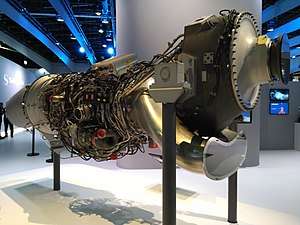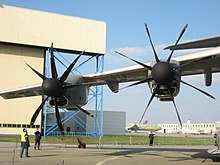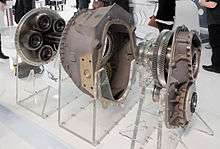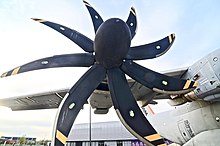Europrop TP400
The Europrop International TP400-D6 is an 11,000 shp (8,200 kW) powerplant, developed and produced by Europrop International for the Airbus A400M Atlas military transport aircraft. The TP400 is the most powerful single-rotation turboprop in service; only the contra-rotating Kuznetsov NK-12 is larger.
| TP400 | |
|---|---|
 | |
| TP400 presented by Safran at the 2017 Paris Air Show. | |
| Type | Turboprop |
| Manufacturer | Europrop International |
| First run | 28 October 2005 |
| Major applications | Airbus A400M |
| Number built | 400+[1] |
Development
The TP400 was originally selected by Airbus Military to power the A400M in December 2000.[2] However, Airbus reopened the engine competition in February 2002, because the engine core, which is based on the Snecma M88 turbofan fighter engine, was too heavy and not sufficiently fuel efficient.[3] By May 2002, Pratt & Whitney Canada (P&WC) announced a proposal involving a 12,000 shp (8,900 kW) turboprop with a core based on its PW800 turbofan,[4] a 53–89-kilonewton (5,400–9,100-kilogram-force; 12,000–20,000-pound-force) regional jet engine under development that had a geared fan at the time;[5] the concept would later be called the PW180.[4] In 2003, around the 30 April decision deadline, Airbus Chief Executive Noel Forgeard told reporters that the P&WC proposal was 20 percent cheaper than for the TP400, and that he would have chosen to give the contract to P&WC, but government officials requested an extension for the companies to revise their bids. Before the final bids were modified, sources claimed that P&WC's offering, which had a European production percentage of 75 percent, was lower by USD$400 million.[6] On 6 May, amidst pressure from European political and business leaders, Airbus awarded a USD$3.4 billion contract to Europrop to produce 900 engines for the A400M, despite accusations of European protectionism.[7] A member of Europrop claimed after the decision that the TP400 contract would only increase the costs of the USD$22.7 billion A400M program by about 1–2 percent compared to if the PW180 had been selected.[4]
.jpg)
The signing of the A400M contract between Airbus Military and the European defense purchasing agency OCCAR on May 27, 2003 marked the beginning of the aircraft development program, which was planned to last 77 months (6 years, 5 months). At the 2003 Paris Air Show, Europrop signed a 300 million euro contract with former engine consortium partner Avio to supply the gearboxes. However, because of torque and aerodynamic problems that Lockheed Martin encountered on its C-130J Super Hercules upgrade, which used new engines and propellers that had half the planned output of the TP400, Airbus retained the option to select the engine configuration and the propeller for itself. The TP400 development schedule, which was considered very ambitious, had the bench run of the engine targeted for within 27 months (2 years, 3 months) of the contract signing, or August 2005. In spite of Europrop's insistence that testing on a specialized engine testbed aircraft was unnecessary, Airbus pushed for such a program on the Airbus A300 or A340 starting 11 months of the first ground tests. The engine testbed program would cost Airbus an estimated €40 million.[8]
In July/August 2003, Airbus signed a contract worth up to USD$830 million with Ratier-Figeac to supply the propellers, which would be 5.33 meters (17.5 feet) in diameter and have eight composite blades.[9] By May 2004, Airbus decided that the A400M design would have a "handed" propeller concept, so that the pair of engines on a wing would rotate in opposite directions. The design required two propellers - the standard propeller, and a mirror-image version. The engine for the mirror-image propeller would need additional gearbox components. This counter-rotating propeller design meant the TP400 engine would have to be certificated for two different gearbox/propeller configurations.[10] Airbus awarded Marshall Aerospace a contract in December 2004 to flight test the TP400 engine on a Lockheed C-130K Hercules aircraft,[11] targeting flights in mid-2006 and hoping for a first flight in April of that year.[12] Other testbed airframes considered were the Ilyushin Il-76 and what was thought to be the favorite, Airbus's own A340-300 testbed aircraft, even though the TP400's large propellers would still have enough ground clearance if it were installed on the A340's low-mounted wing.[13]
According to the engine master program presented in September 2006, the TP400 was to reach its first engine run by the end of August 2005, followed by the first combined engine and propeller run by the end of that year. The TP400 would fly on its own specialized testbed aircraft by the end of 2006, and the engine would be certified with the "handed" propeller by the end of October 2007, 54 months (4 years, 6 months) into the engine program. The first test flight of the TP400-powered A400M would follow by the end of the next month, and engine certification with the baseline propeller would occur by the end of March 2008. Finally, the qualification test would finish by the end of January 2009.[14]:8

After a two-month delay, the engine first ran on 28 October 2005[15] using a water brake as the load. During subsequent testing, the engine reached full power.[16] On 28 February 2006, the engine was tested for the first time with the propeller installed.[17] Europrop delivered the first TP400 engine for engine testbed flight testing on 19 November 2007.[18] In June 2008, the TP400 had a first ground run on the inboard port wing of the C-130K engine testbed, and integration was completed onto the first A400M production aircraft.[19] After 24 hours of ground runs and taxi trials, the first flight of a single TP400-D6 engine took place on 17 December 2008. Airbus and Marshall completed flight testing on the C-130K testbed aircraft completed on 30 September 2009 after 18 flights, 55 flight hours, and 61 hours of ground tests, although the design of the C-130K airframe limited the maximum cruise speed to Mach 0.64 instead of the TP400 propeller's Mach 0.72 maximum.[11] On 18 November 2009, an A400M test aircraft completed a ground run for the first time with all four TP400 engines,[20] quickly followed by the A400M's first taxi trial on 23 November 2009.[21] On 11 December 2009, the maiden flight of the A400M took place.[22] The engine earned civil certification from the European Aviation Safety Agency (EASA) on 6 May 2011.[23] By April 2012, EASA certified Ratier-Figeac's FH385/FH386 propellers for the TP400,[24] and on 13 March 2013 it granted a type certificate for the A400M aircraft.[25] The aircraft and engine officially entered service on 30 September 2013 with the French Air Force.[26]
Several technical problems delayed the engine's certification test program and pushed the entire A400M aircraft program into further scheduling adjustments. The engine delays were primarily due to problems with completing the full authority digital engine control (FADEC) software to the satisfaction of the civil authorities. More specifically, Europrop determined in mid-2008 that the engine worked correctly, but the FADEC software still did not meet EASA requirements.[27] Since the A400M was intended for humanitarian missions, the aircraft also needed to have a civil certification. Europrop did not realize that this meant the FADEC also had to show traceability and accessibility, so EASA denied civil certification of the software. Because of this problem, the first A400M test aircraft, which was flight-ready by September 2008, was not permitted to fly. Europrop had to triple the size of its workforce to fix the issue,[28] resulting in a FADEC system consisting of over 275,000 lines of code, which was four times more complex than the FADEC software for the largest civil jet engine.[29] Other problems included numerous plane subsystems providing insufficient logging to the main aircraft computer.[30]
Further problems arose in 2016 with the main gearbox that showed abnormal wear and heat requiring premature servicing.[31] This problem led to the German Air Force temporarily grounding two of its three A400M aircraft, and also resulted in a Royal Air Force aircraft suffering an inflight engine shutdown.[32] An interim fix for this engine issue was certified in July 2016.[33] The gearbox issues persisted, and as of July 2018, the final fix was planned to be introduced by the end of that year.[34]

Design
The TP400 has a three-shaft configuration, consisting of a two-shaft gas generator followed by a free-power turbine.[14]:10 This configuration was chosen to maximize the overall pressure ratio. The three-shaft setup also results in the engine being shorter and lighter, with higher stiffness to resist bending in flight.[35] The TP400 has a chin air intake,[14]:10 and the engine has a mass flow of 26.3 kilograms per second (3,480 pounds per minute).[36]
In the gas generator, the intermediate pressure compressor (IPC) is designed by MTU Aero Engines and has five stages.[13] To reduce the complexity of the component, the IPC does not have variable inlet or stator vanes.[36] The high-pressure compressor (HPC) is designed by Rolls-Royce. The HPC has six total stages, with four of them as fixed stages (blisks),[37] and the other two as variable stages. Snecma supplied the combustor, which was based on the combustor of its M88 turbofan fighter engine. To drive the HPC, Snecma also supplied the high pressure turbine (HPT), which also based on the HPT of the M88. The intermediate pressure turbine (IPT) driving the IPC is also a derived component, this time from MTU and based on the IPT of the Turbo-Union RB199 and Eurojet EJ200 turbofan fighter engines.[13] Both the Snecma HPT and the MTU IPT have one stage, but the HPT is unshrouded, while the IPT has a shroud.[14]:10 The shaft connecting the IPC to the IPT rotates in opposite direction to the outer shaft that connects the HPC to the HPT. The overall pressure ratio is 25:1.[36] The IP compressor has a pressure ratio of 3.5:1, and the HP compressor a pressure ratio of about 7.2:1.

The low pressure turbine (LPT) is provided by Industria de Turbo Propulsores (ITP), and it is derived from the LPT of the Rolls-Royce BR715 regional turbofan.[13] This free-power turbine drives the propeller through a third coaxial shaft and a reduction gearbox.[36] The Avio-produced gearbox has a maximum power output of about 8,000 kW (11,000 hp). Reduction occurs in two stages: a first-stage offset design, followed by a second-stage planetary system.[38] The total reduction gear ratio is about 9.5:1. The gearbox output torque is up to 100 kilonewton meters (74,000 pound force-feet). Early prototypes of the gearbox were entirely made of aluminum, but magnesium was introduced to save weight.[16] Because the gearbox has to support propeller rotation in both directions, it adds an idler gear to reverse the direction when the gearbox is paired with the "handed" propeller.[36]
The propeller is designed by Ratier-Figeac and has a diameter of 5.33 m (17.5 ft). The reversible, variable-pitch propeller holds eight blades, each having a carbon spar enclosed by a composite shell and a polyurethane coating.[35] Its blades have a scimitar shape[36] that results in a sweep angle of about 55 degrees at the blade tips,[39] which have a helical speed of 290 m/s (951 ft/s; 1,044 km/h; 648 mph) at the A400M's cruise speed of Mach 0.68.[35] The propeller has four rotational speed settings: 655, 730, 842 and 860 rpm.[11] The 655 rpm setting is for low-altitude cruise, 730 rpm for normal cruise, and 842 rpm for takeoff and special maneuvers.[16] The propeller converts the engine power into 110 kN (11,000 kgf; 25,000 lbf) of thrust.[40]
Specifications (TP400-D6)
Data from EASA type certificate data sheet for TP400-D6, issue 07, page 6[41]
General characteristics
- Type: 3-spool axial flow turboprop
- Length: 4.18 m (13 ft 9 in)
- Diameter: 1.218 m (4 ft 0 in)
- Propeller diameter: 5.334 m (17 ft 6.0 in)[42]
- Dry weight: 1,938.1 kg (4,273 lb) for baseline engine (propeller clockwise); 1,965.1 kg (4,332 lb) for handed engine (propeller counter-clockwise)
- Propeller weight: 683 kg (1,506 lb)[42]
Components
- Compressor: MTU 5-stage intermediate pressure compressor, without variable inlet or stator vanes to reduce complexity;[36] Rolls-Royce 6-stage high pressure compressor with 2 variable stages[13]
- Combustors: Snecma[13] annular combustion chamber with 18 fuel nozzles[36]
- Turbine: Snecma single-stage high pressure turbine; MTU single-stage intermediate pressure turbine; ITP 3-stage low pressure turbine[13]
- Fuel type: Jet A, Jet A1, Jet B, JP4, JP5, JP8, and JP8+100[43]
Performance
- Maximum power output: Uprated takeoff: 8,251 kW (11,065 hp); Maximum continuous: 7,971 kW (10,690 hp)[42]
- Overall pressure ratio: 25[36]
- Air mass flow: 26.3 kg/s (58 lb/s)[36]
- Turbine inlet temperature: 1,200 °C (2,190 °F; 1,470 K; 2,650 °R)[36]
- Specific fuel consumption: At takeoff: 0.228 kg/kW/h (0.170 kg/shp/h; 0.37 lb/shp/h)+ (2003 estimate);[8] In cruise: 0.21 kg/kW/h (0.16 kg/shp/h; 0.35 lb/shp/h)[44]
- Power-to-weight ratio: 4.41 kW/kg (5.9 hp/kg; 2.68 hp/lb)[44]
See also
Related lists
References
- "EPI achieves the assembly of the 400th TP400 turboprop" (PDF). Europrop International (Press release). 18 July 2018. Retrieved 11 August 2018.
- "A400M gets its engine". Business briefing. Interavia Business & Technology. Vol. 55 no. 648. December 2000. p. 6. ISSN 0020-5168. OCLC 202195838 – via EBSCOhost.
- Penney, Stewart (26 February 2002). "Bids re-open for Airbus A400M proposition". Engines. Flight International. p. 18. ISSN 0015-3710.
- Fricker, John; Tuttle, Rich (8 May 2003). "Profit margins in A400M engine program will be thin, official says". Aerospace Daily. Vol. 206 no. 28. p. 5. ISSN 0193-4546.
- Penney, Stewart (7 May 2002). "P&WC offers PW800 for A400M". Flight International. Montreal, Quebec, Canada. p. 5. ISSN 0015-3710.
- Lunsford, J. Lynn (7 May 2003). "Airbus bypasses Pratt & Whitney, keeps engine contract in Europe". Wall Street Journal. p. A3. ISSN 0099-9660 – via ProQuest.
- Blackwell, Richard (7 May 2003). "Pratt loses massive European contract". The Globe and Mail. ISSN 0319-0714.
- Coniglio, Sergio (July 2003). "A400M, An-70, C-130J, C-17: How do they stand?". Military Technology (MILTECH). Vol. 27 no. 7. Mönch Publishing Group. pp. 51–60. ISSN 0722-3226. OCLC 95643375 – via EBSCOhost.
- "Ratier-Figeac prop for A400M". Update: Week ending 3 August 2003. Flug Revue. 3 August 2003. Archived from the original on 9 May 2006.
- Doyle, Andrew; Hoyle, Craig; La Franchi, Peter; Morrison, Murdo (18–24 May 2004). "A400M to have 'handed' propellers". Flight International. Vol. 165 no. 4934. p. 15. ISSN 0015-3710. OCLC 98213044.
- Pocock, Chris (2 February 2010). "Flight-testing Europe's huge new turboprop". AINonline.
- Barrie, Douglas (29 November 2004). "Trials of Hercules: Erstwhile competitor will be used to test powerplant for Europe's A400M military airlifter". Aviation Week & Space Technology. Vol. 161 no. 21. London, England, U.K. p. 41. ISSN 0005-2175.
- Norris, Guy (9–15 November 2004). "Power station: For the A400M EuroProp International is developing the most powerful turboprop ever to grace a Western prodution aircraft". A400M: Engines. Flight International. Vol. 166 no. 4959. Toulouse, France. pp. 58–60. ISSN 0015-3710. Archived from the original on 15 November 2010.
- TP400-D6 turboprop: A European collaboration programme (PDF). Rolls Royce Defence Aerospace (Report). Hamburg, Germany. 19 September 2006.
- Coppinger, Rob (7 November 2005). "Successful start for A400M engine". FlightGlobal. Ludwigsfelde, Germany.
- Hoeveler, Patrick (May 2006). "TP400-D6 completes first run with prop". Flug Revue. ISSN 0015-4547. Archived from the original on 9 May 2006.
- Moxon, Julian (23 May 2006). "Power demands". Flight International. Vol. 169 no. 5037. London, England, U.K. ISSN 0015-3710. Archived from the original on 2 July 2020.
- Hoyle, Craig (23 November 2007). "Europrop International delivers first TP400 engine for Airbus Military A400M". FlightGlobal.
- Hoyle, Craig (23 Jun 2008). "Europrop engine for Airbus Military A400M passes milestones". FlightGlobal. Archived from the original on 26 June 2008. Retrieved 9 October 2016.
- Hoyle, Craig (19 November 2009). "A400M completes first ground run of all four engines". FlightGlobal.
- Hoyle, Craig (24 November 2009). "A400M performs first taxi trial". FlightGlobal.
- Hepher, Tim; Siebold, Sabine (11 December 2009). "Buyers outline deal on A400M after debut flight". Seville, Spain. Reuters. Retrieved 12 June 2020.
- Hoyle, Craig (31 May 2011). "EPI boss details progress on A400M engine programme". FlightGlobal.
- "Europe OKs Hamilton's 8-blade propellor". Hartford Business Journal. 6 April 2012. ISSN 1083-5245.
- Donald, David (15 June 2013). "The year of The Atlas A400M". Paris Air Show. AINonline.
- Pocock, Chris (1 October 2013). "Europe's new airlifter ceremonially welcomed". AINonline.
- "Aircraft news - Europe". AirGuide Business (published 11 May 2009). 7 May 2009. ISSN 1939-666X – via TheFreeLibrary.
- Campbell, Keith (8 May 2009). "Aero engine company admits delaying A400M transport aircraft". Creamer Media's Engineering News. Retrieved 27 June 2020.
- Hepher, Tim; Doerr, Kerstin (12 December 2008). Wickham, Chris (ed.). "Analysis - Airbus A400M engine test key for project credibility". Transportation News. Paris, France. Reuters.
- Hepher, Tim (12 June 2009). Shankar, Sitaraman (ed.). "Red tape and red faces in A400M bungle". Paris, France. Reuters. Retrieved 9 July 2020.
- Matthias Gebauer (12 May 2016). "Triebwerksprobleme beim A400M: Bundeswehr plant für den Ernstfall" (in German). Spiegel Online. Retrieved 2 June 2016.
- Gareth Jennings (12 July 2016). "Engine problems ground German A400Ms". IHS Jane's 360. Archived from the original on 21 August 2016. Retrieved 12 July 2016.
- Shalal, Andrea (9 July 2016). "Interim fix for A400M engine issue certified: Airbus". Reuters. Retrieved 12 July 2016.
- Hollinger, Peggy; Buck, Tobias; Pitel, Laura (2 July 2018). "A400M: The €20bn military aircraft that has bedevilled Airbus. European militaries hope airlifter's troubles are behind it more than 15 years after launch". Financial Times. ISSN 0307-1766.
- Mraz, Stephen J. (17 February 2005). "Airbus builds a military airlifter: A new, multirole transporter will replace aging heavy-lift aircraft in military fleets". Cover Story. Machine Design. Vol. 77 no. 4. pp. 98+. ISSN 0024-9114. Archived from the original on 24 June 2020.
- Coniglio, Sergio (February 2010). "Military aircraft propulsion: Jets vs. props". Military Technology (MILTECH). Vol. 34 no. 2. Mönch Publishing Group. pp. 77–84. ISSN 0722-3226. OCLC 527912380 – via EBSCOhost.
- Beauclair, Nicole (Summer 2004). "A400M production plans slot into place". Finance, markets & industry. Interavia Business & Technology. Vol. 59 no. 676. With contributions by Oliver Sutton. pp. 13–16. ISSN 0020-5168. OCLC 98909963 – via EBSCOhost.
- "Propeller gearbox for the TP400-D6, W" (PDF). Avio (Press release). Retrieved June 11, 2020.
- Johanning, Andreas; Scholz, Dieter (23–28 September 2012). Novel low-flying propeller-driven aircraft concept for reduced operating costs and emissions (PDF). Congress of the International Council of the Aeronautical Sciences (28th ed.). Brisbane, Australia. ISBN 978-0-9565333-1-9. OCLC 1061813207.CS1 maint: date format (link)
- Airbus Military (April 2006). "Facts, figures & pictures". A400M Countdown newsletter: A progress report from Airbus Military. Archived from the original on 18 February 2007.
- Europrop International (4 July 2019). Type-certificate data sheet: For TP400-D6 engine (PDF) (Report) (Issue 07 ed.). European Aviation Safety Agency (EASA). Lay summary.
- Ratier-Figeac (15 December 2015). Type-certificate data sheet: For propeller FH385/FH386 series (PDF) (Report) (Issue 04 ed.). European Aviation Safety Agency (EASA). Lay summary.
- Airbus Military (17 December 2015). Type-certificate data sheet: For Airbus A400M (PDF) (Report) (Issue 06 ed.). European Aviation Safety Agency (EASA). Lay summary.
- Kaiser, Sascha; Donnerhack, Stefan; Lundbladh, Anders; Seitz, Arne (27–29 July 2015). A composite cycle engine concept with hecto-pressure ratio. AIAA/SAE/ASEE Joint Propulsion Conference (51st ed.). doi:10.2514/6.2015-4028.
Bibliography
- Hoyle, Craig (17 Nov 2017). "Can TP400 gearbox fix lift Atlas programme?". FlightGlobal.
- "A400M engine flying test bed". Marshall Aerospace and Defence Group. 13 August 2014. Archived from the original on 20 September 2014. Retrieved 9 October 2016.
- Sheahan, Maria; Cutler, David (7 June 2010). Robinson, Simon; Ledwith, Sara (eds.). "Timeline: Fraught journey of A400M transport aircraft". Berlin, Germany. Reuters.
- Dubois, Thierry (17 June 2009). "TP400 nears Fadec trials, certification". Defense. AINonline. Paris, France.
- Hepher, Tim (25 September 2008). Moss, Brian (ed.). "Engine makers hit back at Airbus on A400M". Market News. Paris, France. Reuters.
- Daly, Kieran (1 July 2008). "Rolls-Royce promotes turboprop solution for new civil airliners". FlightGlobal.
- "Ground runs commence on Airbus A400M flight test bed at Marshall Aerospace" (PDF). Teamwork. Marshall Group. Summer 2008. p. 5.
- "Airbus Military A400M flight test bed programme advances at Marshall Aerospace" (PDF). Teamwork. Marshall Group. Spring 2008. p. 8.
- Dubois, Thierry (14 November 2006). "A400M on target for October 2009 delivery". AINonline.
- Nagy, Barbara; Moran, John M. (7 May 2003). "Airbus jettisons Pratt for Euro bid". Hartford Courant. ISSN 1047-4153.
- Nagy, Barbara; Remez, Michael (6 May 2003). "Pratt bid appears to hit bias". Hartford Courant. ISSN 1047-4153.
External links
| Wikimedia Commons has media related to Europrop TP400. |
- Official website
- "Transport: The most powerful turboprop engine in the Western world". ITP Aero. Retrieved June 10, 2020.
- "TP400-D6". MTU Aero Engines. Retrieved June 10, 2020.
- "The engine of the decade". Rolls-Royce. Retrieved June 10, 2020.
- "TP400, the most powerful turboprop in the West". Safran. Retrieved June 10, 2020.